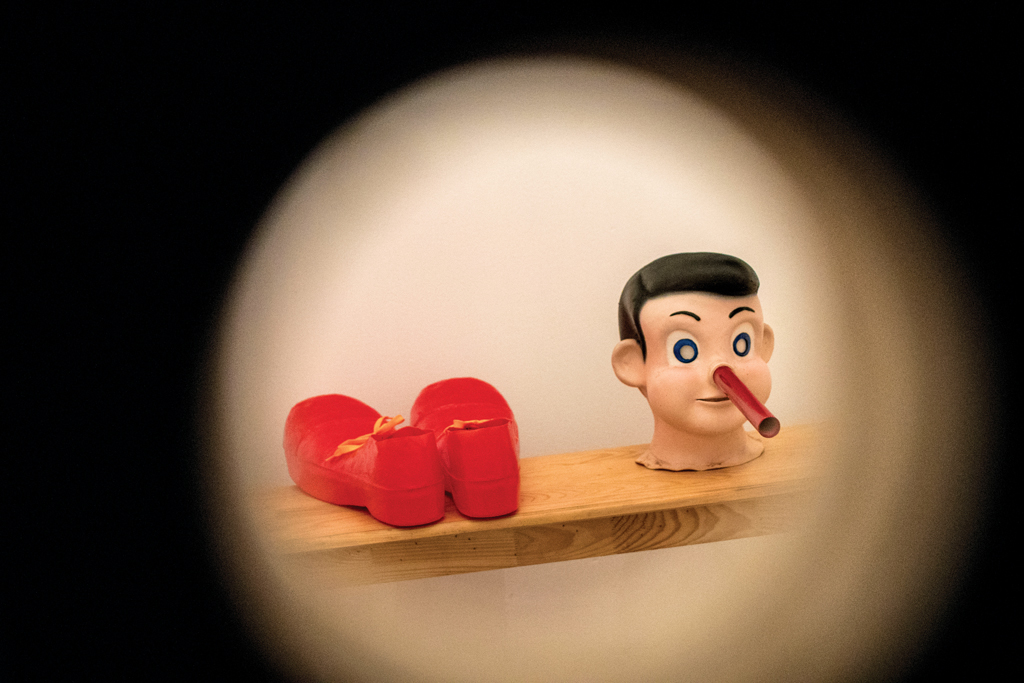[ad_1]
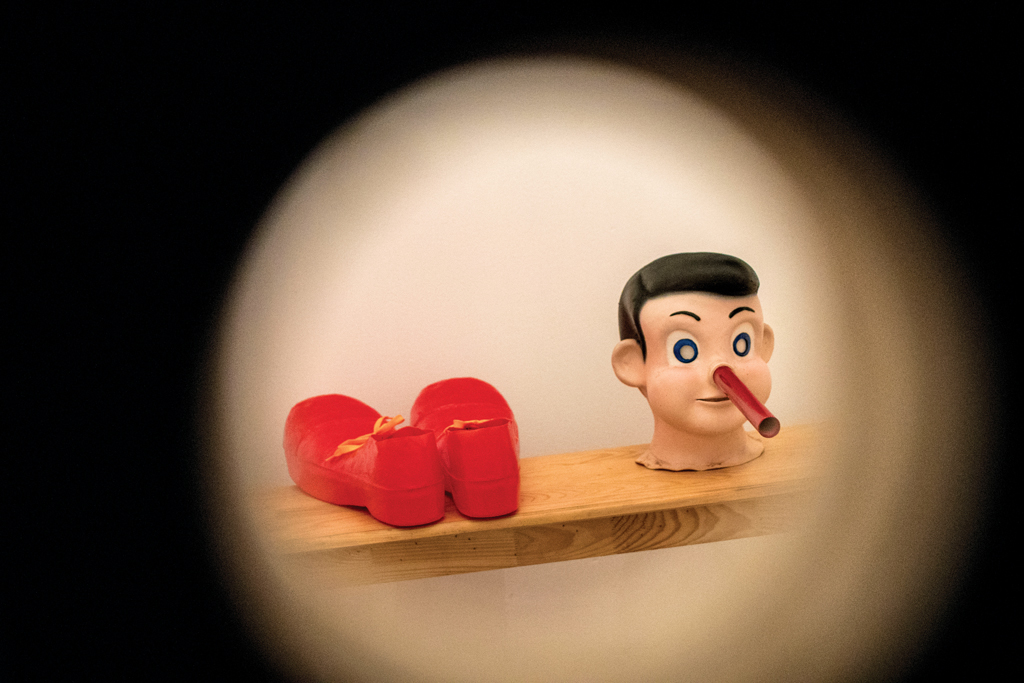
Paul McCarthy, Pinocchio Pipenose Household Dilemma (sculptural elements), 1994, installation view at M Woods, 2018.
©PAUL MCCARTHY/COURTESY THE ARTIST AND HAUSER & WIRTH
In recent years, Shanghai has stolen the spotlight on China’s contemporary art scene, primarily because of the opening of several museums there, both private and public—Rockbund Art Museum and Power Station of Art—and the launching of the West Bund Cultural District, which includes the Long Museum and the Yuz Museum, as well as the soon-to-open Shanghai Tanks founded by collector Qiao Zhibing. All the while, however, Beijing, which, since the Imperial dynasties, has been considered the art capital of China and is today home to some 200,000 artists, has been chugging along, and making its own significant progress. In fact, with new museums and galleries, a major art school and world-class auction houses, Beijing is making something of a comeback. And a good opportunity to gauge the strength of that comeback was the second annual Gallery Weekend Beijing this past March.
Gallery Weekend Beijing debuted in March 2017. Modeled on a similar event in Berlin, it was designed to bring attention to the hard work of galleries in Beijing’s two major art districts—the 798 Art District, a 1950s industrial complex that has been turned into a vibrant neighborhood of galleries, boutiques, cafés, and tchotchke shops; and Caochangdi, a village taken over by numerous freestanding white cubes, many designed by Ai Weiwei—in the week preceding the international art fair Art Basel Hong Kong. The first edition was organized in just six months, giving dealers little time to prepare. But this year, under the direction of Amber Wang, former director of Linda Gallery in Singapore, the 22 participating galleries had more lead time and were able to put their best foot forward for the 1,000-plus VIPs who attended the weekend’s openings and talks.

Liu Wei, Airflow, 2018, cement and glass mirror, dimensions variable. Long March Space.
YANG CHAO PHOTOGRAPHY STUDIO/COURTESY LIU WEI STUDIO AND LONG MARCH SPACE, BEIJING
Long March Space filled its gallery with a thrilling mechanized installation by Liu Wei, with gargantuan geometric forms that moved on tracks around which viewers walked. Tang Contemporary amazed in different ways, with a monumental paper-based sculpture by Zhu Jinshi; and Yang Gallery won the Gallery Weekend’s official best gallery award for its multipart presentation of drawings and installations by Zhang Yue, a young artist who served prison time for murdering a man in self-defense, his contribution here a comment on his experience.
The galleries showing the work of Chinese, however, were outnumbered by those showing Western artists, perhaps disappointing international visitors like dealer Jeffrey Deitch and Los Angeles County Museum of Art director Michael Govan. In addition to local museum exhibitions of Sarah Morris, Paul McCarthy, and Olafur Eliasson, Beijing Commune had Richard Deacon; Boers Li was showing 5XBerlin with Jonathan Meese, Thomas Scheibitz, Anselm Reyle, Katja Strunz, and Thomas Kiesewetter; and Galleria Continua featured Carsten Höller.
“Chinese collectors now travel, visit art fairs, and are more familiar with Western art,” said Waling Boers, coproprietor of Boers Li. “They are very, very curious about what is happening outside the Chinese context.”
At the same time, more and more international artists today want to show in China. “Twenty years ago, if you told a Western artist that he is going to be represented by a Chinese gallery, he would be shocked,” said Lu Jingjing, director of Beijing Commune. “But now, they come and visit and get familiar with China. China is no longer this secret thing. China is not so mystical as in the past.”
The headliner artist from the West showing was McCarthy. His work often features violent and sexual imagery, so he was surprised when the founders of M Woods, a private museum in the 798 Art District, approached him with the idea of bringing a survey of his videos to China. “I had heard stories of censorship from some friends and other artists and I didn’t think it would be possible to pull this off,” McCarthy told me. The opening was mobbed, drawing nearly 1,500 visitors, mostly young people.
Not that young, however: “Paul McCarthy: Innocence,” the artist’s first exhibition in China, which filled the multilevel museum, required visitors to be over 18 years old and to turn in their cell phones at the entrance so that images wouldn’t turn up on WeChat or other social media. Standing in the cavernous central gallery with double-vaulted ceilings watching McCarthy’s seven-hour epic, White Snow (2013), with its orgiastic scenes of cavorting Disney characters, one could not avoid a sense of dislocation. Could this artwork, which was officially rated NC-17 when it was shown at the Park Avenue Armory in 2013, find a home in China? And how would it fare in Beijing, the country’s seat of power, under the ever-more-repressive regime of Xi Jinping?
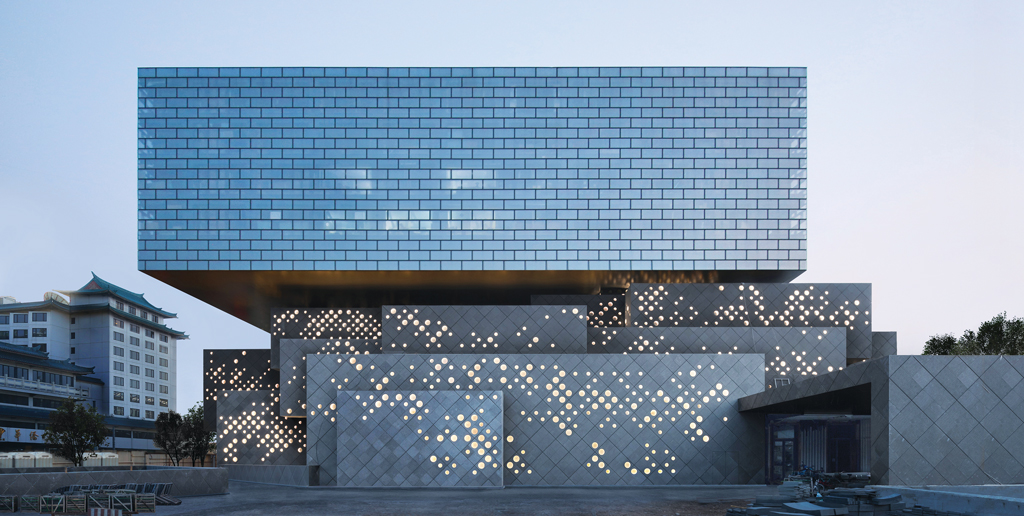
Exterior view of the Guardian Art Center, designed by Ole Scheeren, completed 2018.
©BURO-OS
“Beijing is not a static place; things are always changing and evolving, which is good and exciting,” said Meg Maggio of Pékin Fine Arts, a long-standing dealer in Beijing. As startling as Paul McCarthy’s showing at M Woods is, Maggio points to the new headquarters of China Guardian auction house, towering over Wangfujing Street in the heart of Beijing, as equally remarkable. Overlooking the Forbidden City, the flagship building, designed by Ole Scheeren, formerly of OMA and the driving force behind Beijing’s iconic CCTV headquarters, commandeers a full city block. China’s second-largest auction house, China Guardian is owned by Chen Dongsheng, the largest shareholder in Sotheby’s, with 13.5 percent of its shares. The first season’s sales at the new headquarters, last fall, brought in a whopping 3.039 billion yuan ($484,310,539).
The new headquarters will hold more than auctions. China Guardian has already begun arranging exhibitions of art and antiquities, independent of its sales consignments, in its 18,000-square-foot, column-free gallery space at the building’s center, making this a new destination on the city’s art circuit.
China Guardian’s mammoth achievement is already having ripple effects on the Beijing art market. “Based on the auctions, we knew that prices are much higher in Beijing than in Shanghai, and the more important works are sold in Beijing,” said Bao Yifeng, giving one reason he and his partners David Chau and Kelly Ying have decided to open a new fair in Beijing. As founders of the already successful 5-year-old Art 021 in Shanghai, they launched Jing Art, focusing on modern art and design, rather than contemporary. Powerhouse international galleries David Zwirner and Hauser & Wirth were among the 30 galleries at the inaugural fair this past May, held in a renovated 1905 department store near Tiananmen Square. Beijing already has two other fairs—the 14-year-old CIGE and the 13-year-old Art Beijing—but neither has succeeded in attracting international galleries. They are more regional affairs. Jing Art has higher ambitions. “We want to bring something fresh to Beijing,” said Bao. “We are not trying to compete [against] or defeat other fairs.”
Many attribute this surge of energy to the artists who live and work in Beijing, a concentrated community that encourages creative exchanges. Or so it seemed until earlier this year. As part of a government plan to close down thousands of factories and evict hundreds of thousands of migrant workers, artists in those areas have been thrown out of their studios, often with a day’s notice. Many sought conveniently located studio space elsewhere in the city, only to find that they were priced out of the market, raising questions about the future of this art community. “There’s an upheaval that’s really made me think about environments that are conducive to artists,” said James Elaine, a former curator at the Hammer Museum in Los Angeles who in 2013 opened the Beijing-based Telescope, an incubator for emerging artists in China.
“I always think struggle helps create vital artwork, and I think places like Shanghai don’t have that,” Elaine said, but these recent developments have him questioning that assumption.
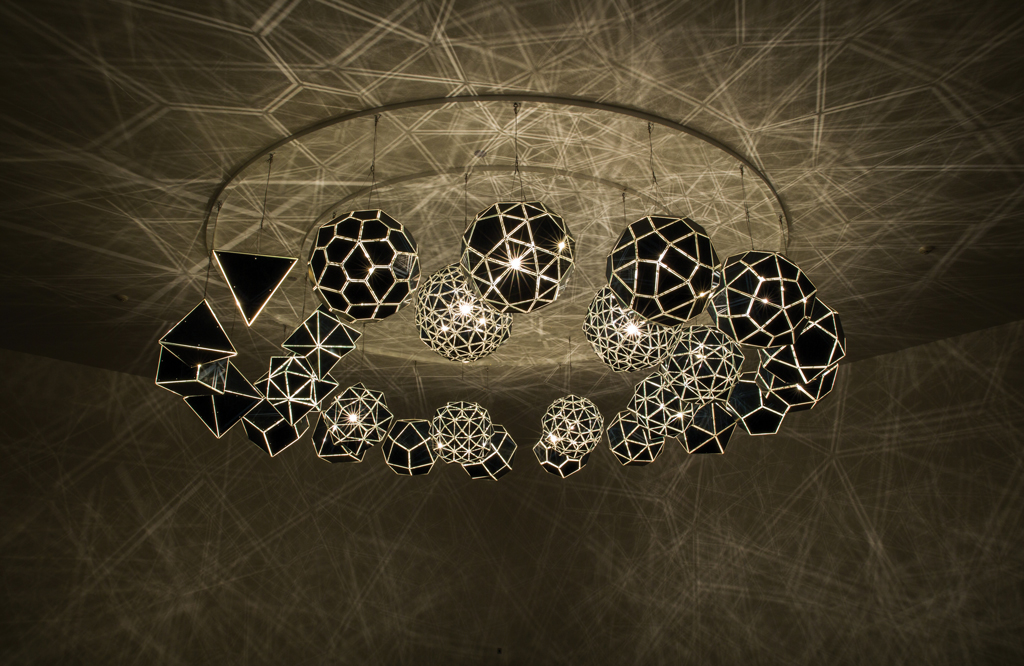
Olafur Eliasson, Your sound galaxy, 2012, stainless steel, mirror, and halogen bulbs, 16′ 7″, installation view. Red Brick Art Museum.
XING YU/©OLAFUR ELIASSON
Ironically, at the same time that many Beijing artists are struggling to retain their work spaces, there has been a resurgence of demand for fresh art in the city, attributable in part to private collectors who are opening up their own institutions. This surge is happening even without the kind of city planning initiative that passed in Shanghai five years ago, spurring its development as a cultural center.
M Woods, where Paul McCarthy was shown, is just one example of these new institutions. Founded in 2014 by a trio of young collectors—Wanwan Lei and her husband Lin Han, and Michael Xufu Huang, a trustee of the New Museum in New York—the institution is chief among those bringing in international art while also showing emerging Chinese artists.
“I think we have always wanted to be experimental, but at the same time, we want to introduce masters who have never had a show in China before,” said Huang, adding that his museum attracts 300,000 visitors a year. “We are like [Paris’s] Palais de Tokyo or the New Museum. We want to do very thoughtful academic shows,” he said. It helps that M Woods has been successful in navigating negotiations with the Ministry of Culture, which oversees every museum exhibition in China.
In the past few years, several other new museums have joined M Woods. The Red Brick Art Museum was founded, also in 2014, by the collecting couple Yan Shijie and Cao Mei. This year, it brought a survey of photographs by Andres Serrano, another provocateur, to China and is more recently exhibiting environmental works by Olafur Eliasson. Another new private museum garnering attention is the six-year-old Sishang Art Museum, whose executive director, Linyao Kiki Liu, is the daughter of Liu Fengzhou, chairman of Hengchangxiang Investment Management Limited. Kiki Liu is known as a contributor to New York’s Museum of Modern Art, hosting a party in Shanghai last November during the Art 021 fair with MoMA PS1 director Klaus Biesenbach.
Last year marked the opening of the Song Art Museum, a bucolic boutique museum surrounded by 1,000 pine trees (“song” means pine in Chinese), located near Beijing’s airport. It was founded by Wang Zhongjun, the CEO of Huayi Brothers Media Corporation, one of China’s largest entertainment companies; on view inside are selections from his collection of works by Picasso, Vincent van Gogh, Alberto Giacometti, and other modern masters.
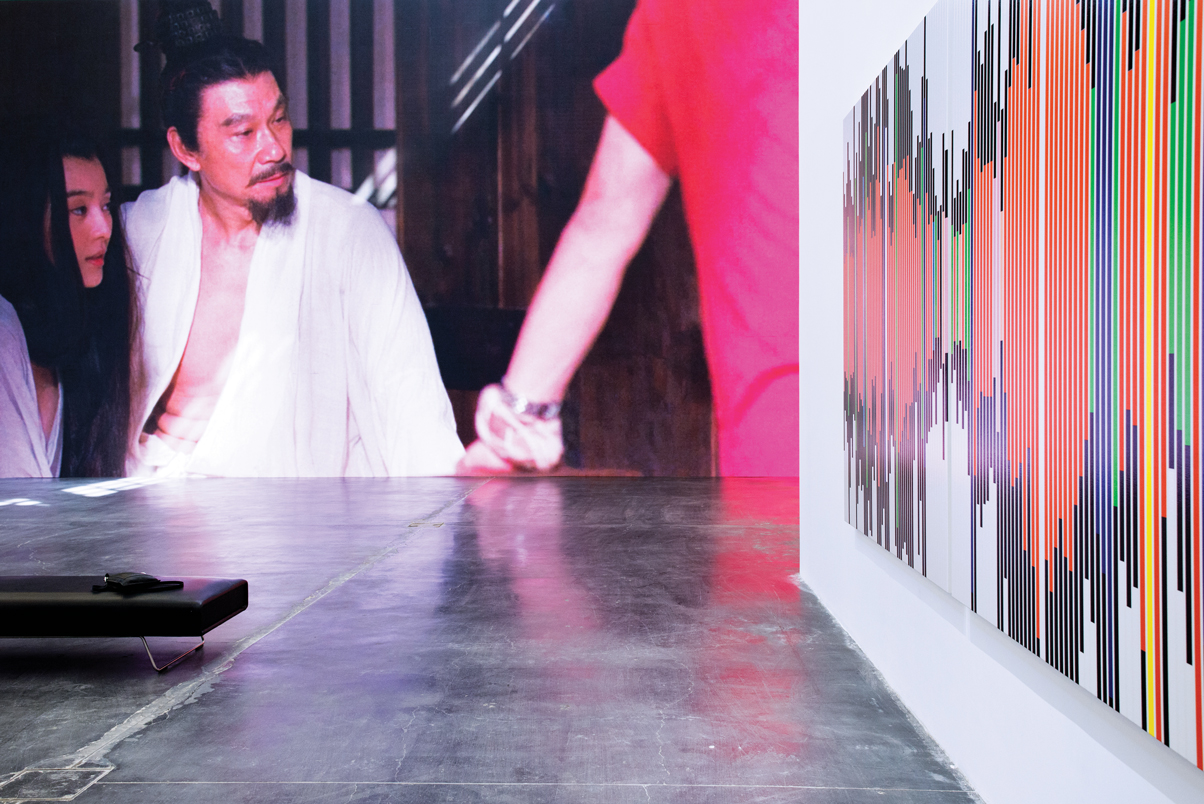
Installation view of “Sarah Morris: Odysseus Factor,” 2018, at UCCA, Beijing.
WENDY BOWMAN
Then there is the decade-old Ullens Center for Contemporary Art, which recently changed ownership. The Ullens is the most successful and ambitious of China’s single-founder museums, with more than 1 million visitors per year. Opened in 2007 by Belgian art collector Baron Guy Ullens and his wife, Myriam, the converted factory with more than 86,000 square feet of exhibition space regularly stages shows of international caliber. During Gallery Weekend Beijing, it hosted “Sarah Morris: Odysseus Factor,” the first exhibition of Morris’s entire filmic output anywhere in the world. Presented on monumental screens, the artworks included her masterpiece, Beijing, filmed during the 2008 Summer Olympics.
“At the deepest level, UCCA is a museum that stands for a cosmopolitan vision of contemporary China, a China that is not nationalistic but also . . . not blindly worshiping of things from outside,” said its director of seven years, Philip Tinari.
For a while, the future of UCCA seemed uncertain. Around five years ago, Baron Ullens started looking to unload the institution, which has a budget of around $10 million a year. Last year, the museum announced that it had found a new group of investors, led by the education corporation Future Edutainment and Chinese advertising billionaire Jason Jiang. Now, according to Tinari, the museum is moving closer to a Western model of a nonprofit with a board of trustees. For the time being, UCCA will function as a bifurcated enterprise with the UCCA Group of investors overseeing its for-profit ventures, such as the museum store and educational programs, and the UCCA Foundation running the museum programming, supported by a patrons council now numbering 40 participants.
“We are the first privately established museum in China to enter the post-founder era,” said Tinari, adding that the museum has already started the process to be fully recognized as a public museum by the Chinese government, anticipating that this transition will take up to five years.
With the new museums come challenges. According to Maggio of Pékin Fine Arts, all the new institutions, not only in Beijing but in second- and third-tier cities throughout China, are making loan requests that the galleries may find increasingly difficult to meet.
“We have to find a way to balance all this activity with the commercial reality of running a business,” Maggio said, noting the rising costs of doing business in Beijing.
With an influx of foreign artists, Beijing is rapidly becoming an international cultural capital, not just the art capital of China. Beijing dealers, curators, and collectors worry about a number of things—the current political regime, the housing crisis for artists, the rising cost of running a gallery—but they seem confident that their city will remain at the forefront. In their minds, Shanghai (as well as all the second- and third-tier Chinese cities opening art districts) is not a threat to their rank. It is a position that Beijing has held for hundreds of years and it’s not letting go anytime soon.
A version of this story originally appeared in the Summer 2018 issue of ARTnews on page 99 under the title “Around Beijing.”
[ad_2]
Source link

